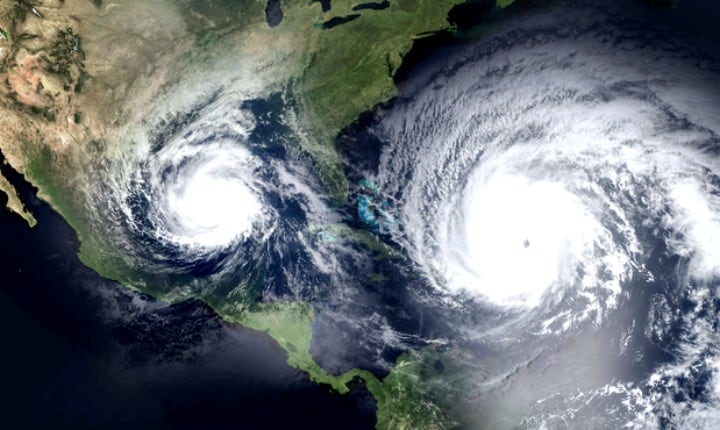Double Deductibles? How Multiple Hurricanes Affect Your Insurance Claims

By Autumn Giusti
Still reeling from hurricanes Florence and Michael, many coastal residents remain on edge as the 2018 storm season has been a double whammy for those living in parts of North Carolina causing a surge in natural disaster insurance claims.
These double storms raise the question of whether homeowners in already affected states could face the prospect of filing multiple insurance claims in a single year and then be on the hook for double deductibles — or more.
RELATED: This Is What Americans Are Googling About Hurricanes
The short answer is that the rules vary from state to state and from policy to policy, and that it’s often up to individual policyholders to find out which rules apply to them.
“It could depend on what is in the policy language, or it may depend on what the state department of insurance has approved and it may not be in (state) statutory language. So it gets a little more complicated to answer the question,” says Paul Tetrault, state and policy affairs counsel for the National Association of Mutual Insurance Companies.
Florida, Louisiana and Rhode Island are three states that have directly addressed this issue by imposing state statutes that prevent insurers from subjecting policyholders to more than one hurricane deductible per year. Some individual policies might also carry similar stipulations, regardless of what state they’re in.
Hurricane deductibles can come as a costly surprise to homeowners who are picking up the pieces from a destructive hurricane. These deductibles apply to damage solely from hurricanes and are based on a percentage of the home’s insured value.
Hurricane deductibles are typically much higher than those for other types of loss and generally make policyholders responsible for 2 percent to 5 percent of the home’s insured value before damage coverage kicks in. So if a house is insured for $300,000 and has a 5 percent deductible, the policyholder must first pay $15,000 of the claim out of pocket. With a standard, non-hurricane deductible, a resident might pay just the first $500 of the claim out of pocket.
Comparing multiple free homeowner’s insurance quotes will be very helpful before something catostrophic happens.
Are multiple hurricanes the new norm?
The 2004 storm season was a game changer for hurricane deductibles in Florida after hurricanes Charley, Frances, Ivan and Jeanne relentlessly assaulted the state.
“When you talked about hurricanes, you’d talk about one. We never experienced before those 2004 storms that you can have multiple storms in one year,” says Lynne McChristian, Florida representative and catastrophe response director for the Insurance Information Institute.
After the 2004 storm season, many Florida homeowners found themselves facing property damages from two or more hurricanes, some of which took place only days apart. Each storm resulted in a separate deductible, and homeowners complained they were being bombarded with expenses.
“They were getting hit more than once with a deductible, so they were looking for some relief,” says Loretta Worters, vice president of media relations for the Insurance Information Institute.
To that end, the state amended its statutes to implement calendar-year deductibles, which limit hurricane deductibles to only one per year. So rather than on a per-occurrence basis, a single deductible would apply on an annual basis, regardless of how many hurricanes damaged the property that year.
In response to hurricanes Katrina and Rita in 2005, Louisiana in 2009 passed its own legislation, modeled after Florida’s deductible rules, to limit deductibles to one per year. And in 2013, Rhode Island enacted its own laws allowing only a single annual deductible.
CHECK OUT: 5 Tips for Renters During Hurricane Season
If it’s unclear whether you face the possibility of having to pay more than one deductible, Tetrault recommends checking with your insurer or agent and with your state department of insurance.
Agents and insurers can help decipher the stipulations of a policy.
“Policy language can be complex, and it might make sense to make a phone call to wherever you purchased your insurance,” Tetrault says.
State insurance departments also serve as information resources to the public and are available to assist policyholders in answering these kinds of questions.
Keep track of damage done by all storms
When filing claims for multiple hurricanes, insurance experts urge residents to report any and all damages — even if they think their damage was less than the deductible amount.
“You want the damage from one to be aggregated into whatever you pay for that deductible,” McChristian said.
If your home has already sustained damages from one hurricane, it’s still necessary to protect your property when it’s in the path of another hurricane. Knowing details about your hurricane insurance policy should be your top priority before a storm hits.
“The big concern is if you don’t have a lot of damage, and then another storm comes through, you want to make sure your home is well secured,” Worters says.
If a home lost a few shingles in the first storm, a second storm could tear off the entire roof if the home isn’t properly protected.
“That’s what we saw after (hurricanes) Rita and Wilma, and the fact that there were storms on top of storms, so there was more damage done to homes,” Worters says.
Even if you are not in the projected path of Nate residents of coastal areas shouldn’t let their guard down until Nov. 30.
“We still have several weeks of hurricane season left,” McChristian says. “The wind doesn’t know if it’s already hit you once.”
